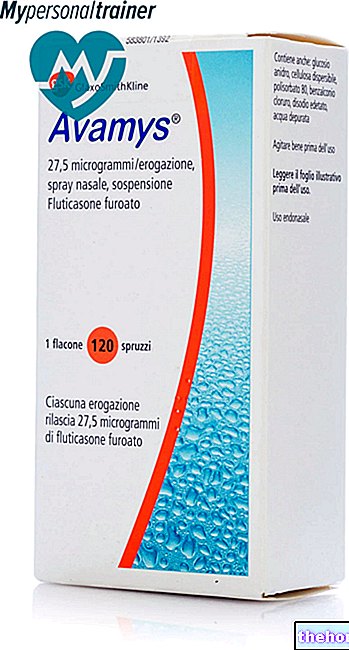Active ingredients: Almotriptan
Almogran 12.5 mg film-coated tablets
Indications Why is Almogran used? What is it for?
Almogran is an anti-migraine drug that belongs to a class of compounds known as selective serotonin receptor agonists. Almogran reduces the inflammatory response associated with migraine by binding to the serotonin receptors in the blood vessels of the brain (head), causing them to narrow.
Almogran is used to relieve the headache associated with migraine attacks with or without aura.
Contraindications When Almogran should not be used
Do not take Almogran:
- If you are allergic to almotriptan or any of the other ingredients of this medicine
- If you have or have ever had diseases that reduce blood flow to the heart such as:
- heart attack,
- chest pain or discomfort that usually occurs with physical activity or stress
- heart problems without pain - chest pain at rest
- severe hypertension (very high blood pressure)
- mild or moderate uncontrolled hypertension.
- If you have had a stroke or reduced blood flow to the brain
- If you have ever had a blockage of the large arteries in the arms or legs (peripheral vascular disease)
- If you have taken other medicines for migraine, including ergotamine, dihydroergotamine, or methysergide, other serotonin agonists (eg sumatriptan)
- If you have severe liver disease
Precautions for use What you need to know before you take Almogran
Talk to your doctor or pharmacist or nurse before taking Almogran,
- If your migraine type has not been diagnosed
- If you are allergic (hypersensitive) to antibacterial medicines generally used to treat urinary tract infections (sulphonamides)
- If your headache symptoms are different from your usual fits, for example if you hear a noise in your ears or feel dizzy, if you have short paralysis on one side of your body or muscles that control eye movement, or if you experience any new symptoms
- If you have risk factors for heart disease such as uncontrolled high blood pressure, high cholesterol, obesity, diabetes, smoking, obvious family history of heart disease or if you are postmenopausal or a male over 40 years of age .
- If you have mild or moderate liver disease
- If you have severe kidney disease
- If you are over the age of 65 (because you are more likely to have increases in blood pressure)
- If you are taking SSRIs (selective serotonin reuptake inhibitors) or SNRIs (serotonin and norepinephrine reuptake inhibitors) antidepressants See also "Other medicines and Almogran".
Excessive use of anti-migraines can lead to chronic headaches.
Children and adolescents
Children under the age of 18 should not take Almogran
Elderly (over 65)
If you are over 65, consult your doctor before taking this medicine.
Interactions Which drugs or foods may change the effect of Almogran
Tell your doctor or pharmacist if you are taking, have recently taken or might take any other medicines.
Tell your doctor
- If you are taking medicines to treat depression such as monoamine oxidase inhibitors (e.g. moclobemide), selective serotonin reuptake inhibitors (e.g. fluoxetine) or serotonin and norepinephrine reuptake inhibitors (e.g. venlafaxine) which can cause the syndrome from serotonin, a potentially dangerous, life-threatening reaction. Symptoms of serotonin syndrome include confusion, restlessness, fever, sweating, uncoordinated movements of the limbs or eyes, uncontrollable muscle spasms or diarrhea.
- If you take preparations containing St. John's wort (Hypericum perforatum) as this may increase the chance of side effects.
Almogran must not be taken at the same time as medicines containing ergotamine, which are also used to treat migraines; however, these medicines can be taken one after the other: leaving an adequate period of time between each drug intake.
- After taking almotriptan, it is recommended that you wait at least 6 hours before taking ergotamine.
- After taking ergotamine, it is recommended that you wait at least 24 hours before taking almotriptan.
Warnings It is important to know that:
Pregnancy and breastfeeding
If you are pregnant or breast-feeding, think you may be pregnant or are planning to have a baby, ask your doctor or pharmacist for advice before taking this medicine.
Few data are available on the use of almotriptan in pregnancy and therefore Almogran should only be used in pregnancy as directed by the physician and only after careful consideration of the benefits and risks.
Use caution while breastfeeding; avoid breastfeeding for 24 hours after taking this medicine.
Driving and using machines
Almogran can cause drowsiness. If you feel drowsy, avoid driving vehicles or operating machines.
Dose, Method and Time of Administration How to use Almogran: Posology
Almogran should only be taken to treat an ongoing migraine attack and not to prevent migraine attacks or headaches.
Always take this medicine exactly as your doctor has told you. If in doubt, you should consult your doctor or pharmacist.
Adults (18-65 years)
The recommended dose is one 12.5 mg tablet taken as soon as possible after the onset of the migraine attack. If the migraine attack does not go away, do not take a second tablet for the same attack.
If you have a second migraine attack within 24 hours, a second 12.5 mg tablet can be taken, but there should be at least two hours between the first and second tablet.
The maximum daily dose is two 12.5 mg tablets in 24 hours.
The tablets must be taken with a liquid (eg water) and can be taken with or without food.
Almogran should be taken as soon as possible after the onset of migraine although it is also effective when taken later in the attack.
Severe kidney disease
If you have severe kidney disease, do not take more than one 12.5 mg tablet in 24 hours
Overdose What to do if you have taken too much Almogran
If you take more Almogran than you should
If you have accidentally taken too many Almogran tablets or if someone else or a child takes this medicine, consult your doctor or pharmacist immediately.
If you forget to take Almogran
Try to take Almogran as prescribed. Do not take a double dose to make up for a forgotten tablet. If you have any further questions on the use of this medicine, ask your doctor or pharmacist or nurse.
Side Effects What are the side effects of Almogran
Like all medicines, this medicine can cause side effects, although not everybody gets them.
Common side effects (may affect up to 1 in 10 people)
- dizziness,
- drowsiness (sleepiness),
- nausea,
- He retched,
- tiredness.
Uncommon side effects (may affect up to 1 in 100 people)
- sensation of tingling, pricking or numbness of the skin (paraesthesia)
- headache
- ringing, noise, or ringing in the ears (tinnitus)
- strong heart beat (palpitations)
- tension in the throat
- diarrhea
- digestive problems (dyspepsia)
- dry mouth
- muscle pain (myalgia)
- skeletal pain
- chest pain
- weakness (asthenia).
Very rare side effects (may affect up to 1 in 10,000 people)
- spasm of the heart vessels (coronary vasospasm)
- heart attack (myocardial infarction)
- fast heart rate (tachycardia)
Frequency unknown (not estimable from available data)
- allergic reactions (hypersensitivity reactions), including edema of the mouth, throat or hand (angioedema)
- severe allergic reactions (anaphylactic reactions)
- convulsions
- vision impairment, blurred vision (visual disturbances can also occur during a migraine attack)
During treatment with Almogran, tell your doctor immediately:
- if you have chest pain, tightness in your chest or throat or any other symptoms that may seem like a heart attack. Tell your doctor immediately and stop taking Almogran tablets.
Reporting of side effects
If you get any side effects, talk to your doctor or pharmacist. This includes any possible side effects not listed in this leaflet. You can also report side effects directly through the National Pharmacovigilance Network of the Italian Medicines Agency, Website: http://www.agenziafarmaco.gov.it
Expiry and Retention
Keep this medicine out of the sight and reach of children
Do not use this medicine after the expiry date which is stated on the blister and carton after "EXP". The expiry date refers to the last day of the month.
This medicinal product does not require any special storage conditions.
Do not throw any medicines via wastewater or household waste. Ask your pharmacist how to throw away medicines you no longer use. This will help protect the environment.
What Almogran contains
The active substance is almotriptan 12.5 mg (as D, L-hydrogenomalate).
The other ingredients are:
Tablet core: mannitol (E-421), microcrystalline cellulose, povidone, sodium starch glycolate, sodium stearyl fumarate
Coating: hypromellose, titanium dioxide (E-171), macrogol 400, carnauba wax Ink: hypromellose, propylene glycol, indigo carmine (E-132)
What Almogran looks like and contents of the pack
Almogran is available as white, round, biconvex, film-coated tablets with a blue A debossed on one side.
Almogran is available in blister packs of 3,4,6,9 tablets.
Not all pack sizes may be marketed
Source Package Leaflet: AIFA (Italian Medicines Agency). Content published in January 2016. The information present may not be up-to-date.
To have access to the most up-to-date version, it is advisable to access the AIFA (Italian Medicines Agency) website. Disclaimer and useful information.
01.0 NAME OF THE MEDICINAL PRODUCT
ALMOGRAN 12.5 MG TABLETS COATED WITH FILM
02.0 QUALITATIVE AND QUANTITATIVE COMPOSITION
Each tablet contains 12.5 mg almotriptan as almotriptan D, L-hydrogen malate.
For the full list of excipients, see section 6.1.
03.0 PHARMACEUTICAL FORM
Film-coated tablets.
White, round, biconvex film-coated tablets with a blue A debossed on one side.
04.0 CLINICAL INFORMATION
04.1 Therapeutic indications
Acute treatment of the headache phase of migraine attacks with or without aura.
04.2 Posology and method of administration
Almogrande should be taken with liquids as soon as possible after the onset of headache associated with migraine although it is also effective when taken later in the attack.
Do not use Almotriptan for migraine prophylaxis.
The tablets can be taken with or without food.
Adults (ages 18 to 65)
The recommended dose is one tablet containing 12.5 mg of almotriptan. If the symptom reappears within 24 hours, a second dose can be taken. This second dose can be taken provided there is a minimum interval of two hours between the two doses.
If the starting dose is ineffective, the effectiveness of a second dose for treating the same attack has not been investigated in controlled clinical trials. Therefore, if the patient does not respond to the first dose, a second dose should not be taken for the same. attack.
The maximum recommended dose is two doses over a 24 hour period.
Children and adolescents (under 18 years of age)
There are no data on the use of almotriptan in children and adolescents, therefore its use is not recommended in this age group.
Elderly (over 65 years of age)
No dose modification is required in the elderly. The safety and efficacy of almotriptan in patients over 65 years of age have not been systematically evaluated.
Kidney failure
No dosage adjustment is required in patients with mild or moderate renal impairment.
Patients with severe renal insufficiency should not take more than one 12.5 mg tablet in any 24 hour period.
Hepatic failure
There are no data on the use of almotriptan in patients with hepatic impairment (see sections 4.3 Contraindications and 4.4 Special warnings and special precautions for use).
04.3 Contraindications
Hypersensitivity to the active substance or to any of the excipients listed in section 6.1.
Like other 5-HT1B / 1D receptor agonists, almotriptan should not be used in patients with a history, symptoms or signs of ischemic heart disease (myocardial infarction, angina pectoris, documented silent ischaemia, Prinzmetal's angina) or with severe hypertension and hypertension. mild or moderate uncontrolled.
Patients with a history of cerebrovascular accident (CVA) or transient ischemic attack (TIA). Peripheral vascular disease.
Concomitant administration of ergotamine, ergotamine derivatives (including methysergide) and other 5-HT1B / 1D agonists is contraindicated.
Patients with severe hepatic impairment (see section 4.2 Posology and method of administration).
04.4 Special warnings and appropriate precautions for use
Almotriptan should only be used if there is a clear diagnosis of migraine. It must not be used to treat basilar, hemiplegic or ophthalmoplegic migraine.
As with other therapies for acute migraine, other potentially serious neurological problems should be ruled out before treating headache in patients without a previous diagnosis of migraine and in migraine patients presenting with atypical symptoms. patients treated with 5-HT1B / 1D receptor agonists. It should be noted that migraine patients may be at higher risk for certain cerebrovascular events (e.g. cerebrovascular accidents, transient ischemic attacks)
In very rare cases, as with other 5-HT1B / 1D receptor agonists, coronary vasospasm and myocardial infarction have been reported.Therefore almotriptan should not be given to patients who may have undiagnosed coronary heart disease without first checking for possible underlying cardiovascular disease. Such patients include postmenopausal women, males over the age of 40 and patients with other risk factors for coronary heart disease, such as uncontrolled hypertension, hypercholesterolemia, obesity, diabetes, smoking, or patients with a clear family history of cardiovascular disease. However, this evaluation may not identify all patients with heart disease and, in very rare cases, severe cardiac effects have occurred after administration of 5-HT1 agonists in patients with no evidence of cardiovascular disease.
Administration of almotriptan may be associated with transient symptoms including chest pain and tension which may be intense and involve the throat (see section 4.8 Undesirable effects). If these symptoms are indicative of ischemic heart disease, no further dose should be taken and appropriate assessments made.
Almotriptan should be prescribed with caution to patients with known hypersensitivity to sulphonamides.
Serotonin syndrome (including altered mental status, autonomic instability and neuromuscular disorders) has been reported with concomitant treatment with triptans and selective serotonin reuptake inhibitors (SSRIs) or serotonin norepinephrine reuptake inhibitors (SNRIs). These reactions can be severe. If concomitant use of triptans and SSRIs or SNRIs is necessary for clinical reasons, monitoring of the patient is advised, especially at the start of treatment, when increasing doses or if further serotonergic treatment is required (see section 4.5). .
It is recommended to wait at least 6 hours after use of almotriptan before administering ergotamine. Conversely, at least 24 hours should elapse after administration of an ergotamine-containing preparation before administering almotriptan. Although in a clinical study in which 12 healthy subjects were administered no additive vasospastic effects were observed when treated orally with almotriptan and ergotamine, these additive effects are theoretically possible (see section 4.3 Contraindications).
Patients with severe renal insufficiency should not take more than one 12.5 mg tablet in any 24 hour period.
Caution is recommended in patients with mild to moderate hepatic disease and treatment is contraindicated in patients with severe liver disease (see section 5.2 Pharmacokinetic properties).
Side effects may be more frequent during concomitant use of triptans and herbal preparations containing St. John's Wort (Hypericum perforatum).
Similar to other 5-HT1B / 1D receptor agonists, almotriptan can cause transient mild increases in blood pressure that may be more pronounced in the elderly.
Excessive use of an anti-migraine drug
Prolonged use of an anti-migraine drug can cause a worsening of migraine. If this occurs or is thought to occur, seek medical advice and discontinue treatment. The diagnosis of "excessive use of migraine drugs" is conceivable in patients who suffer from frequent or daily migraines despite (or because of) the regular use of anti-migraine drugs.
Do not exceed the maximum recommended dose of almotriptan.
04.5 Interactions with other medicinal products and other forms of interaction
Interaction studies have been performed with monoamine oxidase A inhibitors, beta-blockers, selective serotonin reuptake inhibitors, calcium channel blockers, or inhibitors of cytochrome P450 isoenzymes 3A4 and 2D6. No interaction studies are available in vivo for evaluating the effects of almotriptan on other drugs.
As with other 5-HT1 receptor agonists, the potential risk of a serotonin syndrome due to pharmacodynamic interaction with concomitant treatment with MAO inhibitors cannot be excluded.
There are reports available describing patients with symptoms consistent with serotonin syndrome (including changes in mental status, autonomic instability and neuromuscular disorders) following treatment with selective serotonin reuptake inhibitors (SSRIs) or serotonin and norepinephrine reuptake inhibitors ( SNRI) and triptans (see section 4.4).
Repeated administration of the calcium channel blocker verapamil, a substrate of CYP3A4, resulted in a 20% increase in Cmax and AUC of almotriptan. This increase is not considered clinically relevant. No clinically significant interactions have been observed.
Repeated administration of propranolol did not change the pharmacokinetics of almotriptan. No clinically significant interactions were observed.
Education in vitro on human liver microsomes performed to evaluate the ability of almotriptan to inhibit the major enzymes of cytochrome P450 (CYP) and human monoamine oxidase (MAO), demonstrated that almotriptan is not expected to modify the metabolism of drugs metabolised through cytochrome CYP enzymes , MAO-A and MAO-B.
04.6 Pregnancy and lactation
Pregnancy
For almotriptan, few data are available in pregnant patients. Animal studies do not indicate direct or indirect effects on pregnancy, embryonal / fetal development, parturition or postnatal development (see section 5.3).
Caution should be exercised when prescribing the medicine to pregnant women.
Feeding time
There are no data on the excretion of almotriptan in human milk. Studies in rats have shown that almotriptan and / or its metabolites are excreted in milk.
Therefore caution should be exercised when prescribing almotriptan to breastfeeding women. Infant exposure can be minimized by avoiding breastfeeding for 24 hours after treatment.
04.7 Effects on ability to drive and use machines
No studies on the effects of almotriptan on the ability to drive and use machines have been performed. However, as somnolence may occur during a migraine attack, and somnolence being one of the side effects encountered during almotriptan therapy, it is recommended that patients undergoing specialized operations be exercised with caution.
04.8 Undesirable effects
Almogran has been evaluated in clinical studies for up to one year in over 2700 patients. The most common adverse reactions observed at therapeutic doses were dizziness, somnolence, nausea, vomiting and fatigue. None of these adverse reactions had an incidence greater than 1.5%.
The following adverse reactions have been observed in clinical trials and / or post-marketing experience. They are listed by systemic and organ class (SOC) and in order of decreasing frequency. In terms of frequency they are defined as: very common (> 1/10), common (≥1 / 100,
* However, visual disturbances can also occur during a migraine attack
Reporting of suspected adverse reactions
The reporting of suspected adverse reactions occurring after the authorization of the medicinal product is important, as it allows continuous monitoring of the benefit / risk ratio of the medicinal product. Healthcare professionals are asked to report any suspected adverse reactions through the National Pharmacovigilance Network of Italian Medicines Agency, Website: www.agenziafarmaco.gov.it/it/responsabili.
04.9 Overdose
The most frequently reported adverse reaction in patients treated with 150 mg (the highest dose administered to patients) was somnolence.
Any overdose should be treated symptomatically and with maintenance of vital functions. Since the half-life of the drug is 3.5 hours, the patient should remain under observation for at least 12 hours or as long as symptoms or signs of overdose persist.
05.0 PHARMACOLOGICAL PROPERTIES
05.1 Pharmacodynamic properties
Pharmacotherapeutic group: anti-migraines. Selective 5-HT1 receptor agonists.
ATC code: N02CC05.
Mechanism of action
Almotriptan is a selective agonist of 5-HT1B and 5-HT1D receptors. These receptors mediate vasoconstriction of certain cranial vessels, as demonstrated by studies using isolated human tissue preparations. Almotriptan also interacts with the trigeminovascular system by inhibiting the extravasation of plasma proteins from the vessels of the dura mater following stimulation of the Gasser ganglion, which is a characteristic of neuronal inflammation and appears to be involved in the pathophysiology of migraine. Almotriptan has no significant action on other 5-HT receptor subtypes and has no significant affinity for adrenergic, adenosine, angiotensin, dopamine, endothelin or tachykinin binding sites.
Pharmacodynamic effects
The efficacy of almotriptan in the acute treatment of migraine attacks was demonstrated in four placebo-controlled multicenter clinical trials, in which more than 700 patients were given doses of 12.5 mg. Pain relief began 30 minutes later. administration, while the response rate (reduction in headache from moderate / severe to mild or absent) after 2 hours was 57-70% with almotriptan and 32-42% with placebo. Almotriptan also relieved nausea , photophobia and phonophobia associated with migraine attacks.
05.2 Pharmacokinetic properties
Almotriptan is well absorbed, presenting an oral bioavailability of approximately 70%. The maximum plasma concentration (Cmax) is observed approximately 1.5 to 3.0 hours after administration. The rate and rate of absorption are independent of the concomitant ingestion of food. In healthy subjects following single oral doses ranging from 5 mg to 200 mg, Cmax and AUC were dose proportional, indicating linear pharmacokinetic behavior. The elimination half-life (t½) in healthy subjects is approximately 3.5 hours. There is no evidence of sex-related dependence of almotriptan pharmacokinetics.
More than 75% of the administered dose is excreted in the urine, the remainder in the faeces. Approximately 50% of the recovered dose in urine and faeces consists of unchanged almotriptan. The major biotransformation pathway is monoamine oxidase (MAO-A) mediated oxidative deamination up to the indole acetic metabolite. Other enzymes involved in the metabolism of almotriptan are cytochrome P450 (isoenzymes 3A4 and 2D6) and flavin mono-oxygenase. None of the metabolites have significant pharmacological activity.
After intravenous administration of a dose of almotriptan to healthy volunteers, the mean values of the volume of distribution, total clearance and elimination half-life were 195 liters, 40 liters / hour and 3.4 hours, respectively. About two thirds of the total clearance is attributable to renal clearance (CLR), renal tubular secretion is also likely to be involved in this process. CLR correlates well with renal function in patients with mild (creatinine clearance: 60-90 ml / min), moderate (creatinine clearance: 30-59 ml / min) and severe (creatinine clearance: concentration) renal insufficiency maximum plasma concentration (Cmax) of almotriptan was 9%, 84% and 72%, respectively, while the increase in exposure (AUC) was 23%, 80% and 195%, respectively. According to these results, the reduction in total clearance of almotriptan was -20%,
-40% and -65% in patients with mild, moderate and severe renal impairment, respectively. As expected, total clearance (CL) and renal clearance (CLR) decreased, albeit clinically insignificant, in healthy elderly volunteers compared to a control group of young subjects.
Based on the clearance mechanisms of almotriptan in humans, approximately 45% of the elimination of almotriptan appears to be attributable to hepatic metabolism. Therefore, even if clearance processes are totally blocked or impaired, almotriptan plasma levels should increase to a maximum of 2-fold compared to control, assuming that renal function (and renal clearance of almotriptan) are not affected by hepatic insufficiency. In patients with severe renal insufficiency, Cmax is increased by 2-fold and AUC by approximately 3-fold. compared to healthy volunteers. In patients with significant hepatic insufficiency, changes in pharmacokinetic parameters should not, at best, exceed these values. For this reason, no pharmacokinetic studies of almotriptan have been performed in patients with hepatic impairment.
05.3 Preclinical safety data
In pharmacology studies evaluating safety, repeated dose toxicity and reproductive toxicity, adverse effects were observed only at exposures well above the maximum in humans.
Almotriptan did not show any mutagenic activity in a standard series of genotoxicity studies in vivo And in vitro and no carcinogenic potential was observed in the mouse and rat studies.
As with other 5-HT1B / 1D receptor agonists, almotriptan binds to melanin. However, no drug-associated adverse eye reactions were observed after administration for up to one year in dogs.
06.0 PHARMACEUTICAL INFORMATION
06.1 Excipients
Nucleus:
Mannitol
Microcrystalline cellulose
Povidone
Sodium starch glycolate
Sodium stearyl fumarate
Coating:
Hypromellose
Titanium dioxide (E-171)
Macrogol 400
Carnauba wax
Ink:
Hypromellose
Propylene glycol
Indigo carmine (E-132)
06.2 Incompatibility
Not relevant.
06.3 Period of validity
5 years.
06.4 Special precautions for storage
This medicinal product does not require any special storage conditions.
06.5 Nature of the immediate packaging and contents of the package
Cartons containing aluminum blisters of 3, 4, 6, 9 tablets. Not all packs are on the market.
06.6 Instructions for use and handling
No special instructions.
07.0 MARKETING AUTHORIZATION HOLDER
ALMIRALL SpA
Via Messina 38, Torre C
20154 Milan
08.0 MARKETING AUTHORIZATION NUMBER
Pack of 3 film-coated tablets of 12.5 mg - AIC n. 034996013
Pack of 4 film-coated tablets of 12.5 mg - AIC n. 034996025
Pack of 6 film-coated tablets of 12.5 mg - AIC n. 034996037
Pack of 9 film-coated tablets of 12.5 mg - AIC n. 034996049
09.0 DATE OF FIRST AUTHORIZATION OR RENEWAL OF THE AUTHORIZATION
27/12/2000 / Last renewal October 2012
10.0 DATE OF REVISION OF THE TEXT
February 2014




























